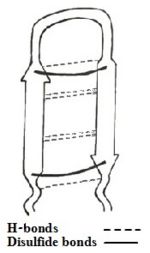Tachyplesin
From Proteopedia
(Difference between revisions)
| Line 42: | Line 42: | ||
<scene name='67/671725/Cdt/1'>Cystein Deleted Tachyplesin</scene> (CDT) is a linear mutant lacking the cysteines and therefore lacking the disulfide bonds (NH₂-Lys-Trp-Phe-Arg-Val-Tyr-Arg-Gly-Ile-Tyr-Arg-Arg-Arg-CONH₂). It contains a broad spectrum of bactericidal activity with a reduced hemolytic property that stems from selective interactions with the negatively charged lipids including LPS. | <scene name='67/671725/Cdt/1'>Cystein Deleted Tachyplesin</scene> (CDT) is a linear mutant lacking the cysteines and therefore lacking the disulfide bonds (NH₂-Lys-Trp-Phe-Arg-Val-Tyr-Arg-Gly-Ile-Tyr-Arg-Arg-Arg-CONH₂). It contains a broad spectrum of bactericidal activity with a reduced hemolytic property that stems from selective interactions with the negatively charged lipids including LPS. | ||
| - | CDT has been demonstrated to markedly inhibit the growth of Gram negative and Gram positive bacterial strains akin to TP-I. But, minimum inhibitory concentration (MIC) values for CDT were found to be lower against <i>Escherichia coli</i> and <i>Listeria monocytogenes</i> in comparison to the wild type TP-I peptide. | + | CDT has been demonstrated to markedly inhibit the growth of Gram negative and Gram positive bacterial strains akin to TP-I. But, minimum inhibitory concentration (MIC) values for CDT were found to be lower against [http://en.wikipedia.org/wiki/Escherichia_coli <i>Escherichia coli</i>] and [http://en.wikipedia.org/wiki/Listeria_monocytogenes <i>Listeria monocytogenes</i>] in comparison to the wild type TP-I peptide. |
<b><u> CDT Structure </u></b> | <b><u> CDT Structure </u></b> | ||
| Line 64: | Line 64: | ||
Evidences suggest that TP-1 has ability to permeabilize the cell membranes of pathogens.<ref name=Laederach>PMID:12369825</ref>. Also, LPS and DNA being the potential biological targets of the peptide, its antimicrobial activity might be exploited. Eyeing the potential of TP-1, it has been insetred successfully in genome of ''Ornithogalum dubium'' and ''Ornithogalum thyrsoides''. These ornamentals plants were originally sensitive to soft rot erwinias (SREs) and insertion of TPI in the plants has successfully protected them without affecting their normal physiology <ref name=Lipsky>PMID:25438795</ref>. | Evidences suggest that TP-1 has ability to permeabilize the cell membranes of pathogens.<ref name=Laederach>PMID:12369825</ref>. Also, LPS and DNA being the potential biological targets of the peptide, its antimicrobial activity might be exploited. Eyeing the potential of TP-1, it has been insetred successfully in genome of ''Ornithogalum dubium'' and ''Ornithogalum thyrsoides''. These ornamentals plants were originally sensitive to soft rot erwinias (SREs) and insertion of TPI in the plants has successfully protected them without affecting their normal physiology <ref name=Lipsky>PMID:25438795</ref>. | ||
| + | [http://en.wikipedia.org/wiki/Escherichia_coli <i>Escherichia coli</i>] and [http://en.wikipedia.org/wiki/Staphylococcus_aureus <i>Listeria monocytogenes</i>] are Gram-negative and Gram-positive bacteria, respectively. They are the most common intestinal tract pathogenic bacteria in animals and humans. | ||
== Possible Function as anti-tumor peptide == | == Possible Function as anti-tumor peptide == | ||
Revision as of 07:08, 7 January 2015
Introduction
| |||||||||||
References
- ↑ 1.0 1.1 1.2 Laederach A, Andreotti AH, Fulton DB. Solution and micelle-bound structures of tachyplesin I and its active aromatic linear derivatives. Biochemistry. 2002 Oct 15;41(41):12359-68. PMID:12369825
- ↑ 2.0 2.1 Chen, Yixin, et al. "RGD-Tachyplesin inhibits tumor growth." Cancer research 61.6 (2001): 2434-2438.
- ↑ Nakamura, Takanori, et al. "Tachyplesin, a class of antimicrobial peptide from the hemocytes of the horseshoe crab (Tachypleus tridentatus). Isolation and chemical structure." Journal of Biological Chemistry 263.32 (1988): 16709-16713
- ↑ Kushibiki T, Kamiya M, Aizawa T, Kumaki Y, Kikukawa T, Mizuguchi M, Demura M, Kawabata SI, Kawano K. Interaction between tachyplesin I, an antimicrobial peptide derived from horseshoe crab, and lipopolysaccharide. Biochim Biophys Acta. 2014 Jan 2;1844(3):527-534. doi:, 10.1016/j.bbapap.2013.12.017. PMID:24389234 doi:http://dx.doi.org/10.1016/j.bbapap.2013.12.017
- ↑ 5.0 5.1 Saravanan R, Mohanram H, Joshi M, Domadia PN, Torres J, Ruedl C, Bhattacharjya S. Structure, activity and interactions of the cysteine deleted analog of tachyplesin-1 with lipopolysaccharide micelle: Mechanistic insights into outer-membrane permeabilization and endotoxin neutralization. Biochim Biophys Acta. 2012 Mar 23;1818(7):1613-1624. PMID:22464970 doi:10.1016/j.bbamem.2012.03.015
- ↑ 6.0 6.1 Hong, Jun, et al. "Mechanism of tachyplesin I injury to bacterial membranes and intracellular enzymes, determined by laser confocal scanning microscopy and flow cytometry." Microbiological research (2014).
- ↑ Yonezawa A, Kuwahara J, Fujii N, Sugiura Y. Binding of tachyplesin I to DNA revealed by footprinting analysis: significant contribution of secondary structure to DNA binding and implication for biological action. Biochemistry. 1992 Mar 24;31(11):2998-3004. PMID:1372516
- ↑ Lipsky A, Cohen A, Ion A, Yedidia I. Genetic transformation of Ornithogalum via particle bombardment and generation of Pectobacterium carotovorum-resistant plants. Plant Sci. 2014 Nov;228:150-8. doi: 10.1016/j.plantsci.2014.02.002. Epub 2014 Feb, 12. PMID:25438795 doi:http://dx.doi.org/10.1016/j.plantsci.2014.02.002
Proteopedia Page Contributors and Editors (what is this?)
Shulamit Idzikowski, Janak Raj Joshi, Michal Harel, Alexander Berchansky, Joel L. Sussman, Angel Herraez, Jaime Prilusky

